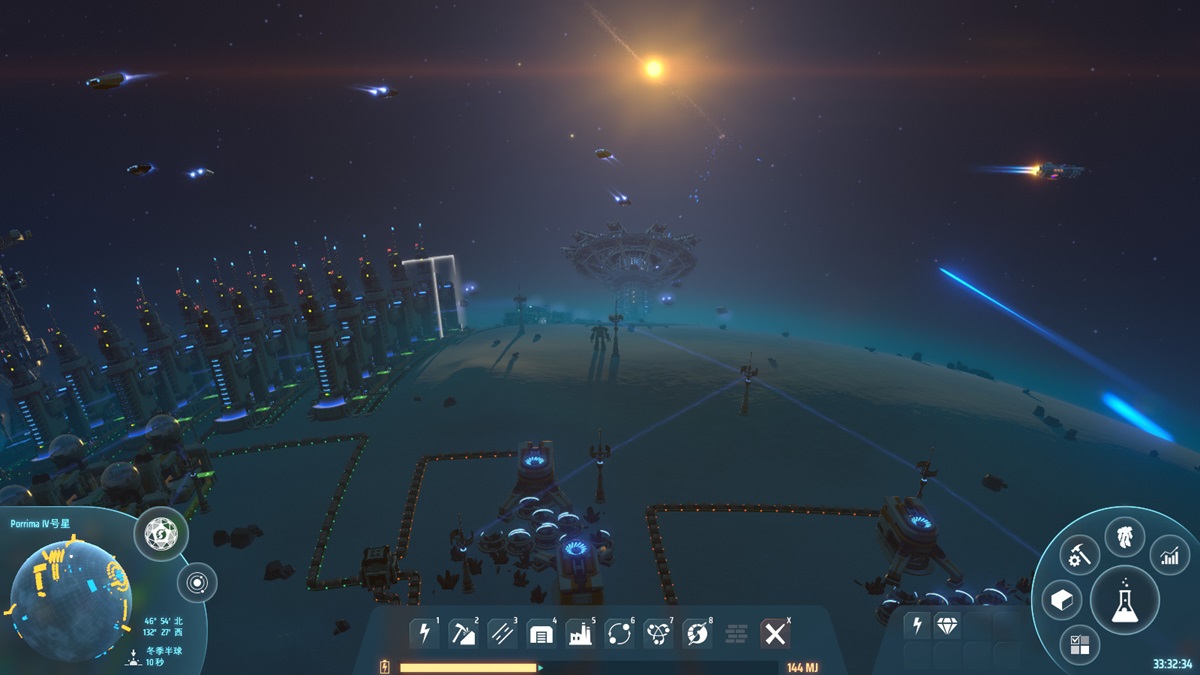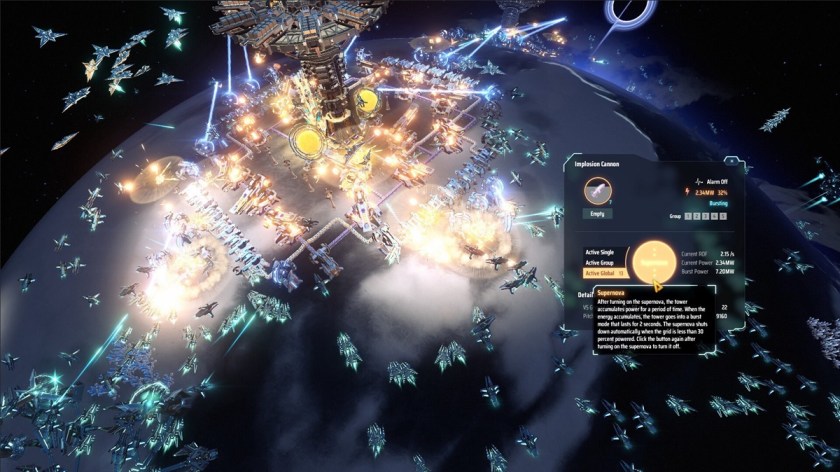Three years ago, base builder and space simulation game Dyson Sphere Program was released and quite frankly blew my mind. I had already invested over 1,000 hours in Factorio and over 100 hours into Satisfactory, so I knew Dyson Sphere Program would be a game for me. What I didn’t expect, however, was the massive scope of the game.
If you haven’t played it—you really owe it to yourself to—Dyson Sphere Program basically drops you onto a planet in a bigger solar system, where you have to build up functioning factories to harvest the resources on the planet and tech up. Eventually, you’ll leave that planet to find others with different resources, then set up a massive solar system-spanning production line that eventually expands across the galaxy. All of this with one goal in mind: to build a Dyson Sphere, a megastructure that encircles and harnesses the power of a sun. To say the game is big is an understatement.
Recently Dyson Sphere Program received an update titled the Dark Fog that added combat via a new alien threat of self-replicating machines aptly called the Dark Fog.
I recently had the opportunity to speak with Zhou Xun, producer at developer YouthCat Games, about the Dark Fog update as well as the future of Dyson Sphere Program.

The Dark Fog Update
Destructoid: The new Dark Fog update is a very unique way to introduce combat to this already unique factory-building genre. What was the overall goal when adding Dark Fog to the game, and how did it get to its current state?
Zhou: The combat system was a key element of our original development plans, with The Dark Fog manifesting itself as a fleshed-out concept relatively early.
It was important that its role in the game made sense to the setting, so we landed on the concept of it being a self-replicating machine hive-mind, competing for energy to support the Centrebrain. Being an enemy that exists before the player begins their own Dyson Sphere Program, it creates an easy to believe and engaging conflict mechanic.
Once we locked down the ‘lore’ of the Dark Fog, next came identifying the visual elements to create something immediately identifiable to players. We wanted a sinister but luminous finish on their units, demonstrating their technological superiority from the outset. Their movement in large groups, seemingly endless in nature, gives them an incorporeal feel.
Our goal was to provide a juxtaposition to the calmer, peaceful building gameplay for players who wanted the extra challenge, and the visual flair the Dark Fog offers really brought this to life. For players looking for added excitement, it provides an entirely new way to play the game, and reinforces smart and considered building. Dyson Sphere Program has a dedicated and expert player base already, so it’s our job to give them an exciting change to the existing formula they know and love.
Destructoid: Is this the final form of Dark Fog, or do you plan to update and evolve the combat system even further?
Zhou: This update is just the beginning of getting to know the threat of The Dark Fog. Currently, most fights occur on ground level, with the scale of space battles starting off small.
We are building on this with the goal of creating large scale fights, with brand new space-based weapons, huge fleets and more so that players can match their aggression and take the war to their enemies.
We’re also exploring adding ‘ultimate’ weapons, which will enable players to remove the threat of the Dark Fog for good. We’re working diligently on enriching the combat experience and expanding on its promise, with the support of our community who have already offered excellent feedback.
Destructoid: I haven’t gotten super far into the update but already the Dark Fog Hive is massive in my system, how big can the hive actually get? Also, how does the Dark Fog expand and assimilate other planets?
Zhou: The initial size of a hive resembles the scale of a planet, but this grows as it develops and expands. Eventually, players will be dealing with a monstrous star-sized hive, shaped like a giant, threatening snowflake. When players arrive on planets close to the orbit of a hive, they will soon see it loom over the skyline as it grows in size, which is a fun, if oppressive, visual.
The Dark Fog expands in two ways; between galaxies and within the same galaxy. Later growth stages will develop a seed which will travel to new galaxies and begin building there.
Each hive will also produce relay stations, moving between planets to establish bases. You may have seen these already, large machines that travel across planets, transporting energy and absorbing matter as they go.
So, overall, the Dark Fog is always developing, traveling and making new bases, which can be tracked in the starmap.
Destructoid: For players who may not know exactly how the system works, can you provide some insight to how this unique system adds a new enemy threat while also making sure they scale with players so that the player doesn’t always feel rushed or like they are falling behind?
Zhou: In order to avoid either the player or The Dark Fog unfairly developing faster than each other, the Dark Fog system closely monitors the player’s data. Statistics such as power generation, power consumption and potential damage outputs are all tracked.
As this is a factory game power consumption, for example, is a vital performance indicator that demonstrates how a player is performing. A higher power use indicates an increase of output, which the Dark Fog will see as a growing threat. They understand that the more power you are using, the more likely you are to have the resources to attack them. From there, they will increase the amount of pressure they put on the player, resulting in more frequent attacks.
However, we also ensure that the Dark Fog isn’t able to outpace the player. As battles play out, the Dark Fog will gain experience, slowly building their power. So, if a player is passive, they will find the Dark Fog develops slowly, allowing them to stockpile defenses.
A highly aggressive player will find a worthy opponent, with more frequent attacks and higher damage output. This system is designed to ensure that each player faces a threat relative to their own, to keep the challenge balanced and rewarding.
The Dark Fog itself was designed with an almost biological, plant-based development in mind, one that grows slowly and roots itself into a world. We wanted to ensure they weren’t like other enemies in tower defense games, which tend to focus on attacks via a countdown or a gradual challenge increase beyond the player’s control. The Dark Fog is a unique threat that has a logic to it, one that is controllable and integrates well with the existing automation factory gameplay. It means that players have to interact with it strategically and learn to work around the Dark Fog’s threat. For example, rushing to build a high-power use factory will lead to more attacks, but a considered, defensive approach will mean the Dark Fog is held at bay. However, the rewards for an offensive approach are highly valuable, which incentivizes players away from hiding behind gun turrets.

The future
Destructoid: Now that combat exists in Dyson Sphere Program, do you plan to add any more enemies or forces alongside the Dark Fog?
Zhou: Our first step is to optimize the current gameplay, and bring improvements to the combat system. From there, we will work on key goals for the combat update, and bring it to a baseline that allows for exciting gameplay in space and on the surface of planets.
It’s a great framework for further development, and beyond the launch of the 1.0 version, we’ll be creating more content to build it out.
Destructoid: This is truly a monumental update to an already massive game. What’s next for Dyson Sphere Program?
Zhou: Optimization is a big part of our future plans, but there will be updates for the base game alongside this. Players were very excited for the combat update, and building on this will continue being a big focus for us. We want to ensure that we’re focusing on polishing the base game, and developing for a really strong experience for launch.
Destructoid: Any plans for additional free or paid big updates like this?
Zhou: The ‘Space Workstation’, a milestone reached during the crowdfunding campaign, is in development. This will be included as a free update for our players.
As for paid content, we haven’t made decisions on this yet as we still have a lot to consider about the game and rollout of future updates.
Our goal is to finish the content promised first, as that’s what our audience deserves and expects. Once that’s completed, we’ll take time to see if any ideas for future content are good enough and are worthy of our players’ investment.
Destructoid: Even though DSP is in Early Access, it’s extremely polished compared to most with that moniker. How long do you plan for DSP to be in Early Access and ideally what does the final product look like?
Zhou: We appreciate the compliment, it’s great to hear what people are thinking about the game as it helps us to know we’re on the right track.
In all honesty, there are still many parts of the game that we feel are in their early access phase. UI, key settings, more and better localization are all areas we are constantly working on.
We’re conscious of the fact that a 1.0 launch can feel like a signal that developers are changing their focus, or even ending the development of the game. That’s not our approach; we want the game to reach the potential our players expect.
We currently don’t have a date for the 1.0 launch, as we have plenty of updates we want to test with our community. This will help the community generate their own expectations of what they feel a 1.0 version looks like, so that when we do decide to launch the game fully, it will feel deserved.
Dyson Sphere Program and the new Dark Fog update are currently available on Steam.













Published: Jan 25, 2024 04:05 pm